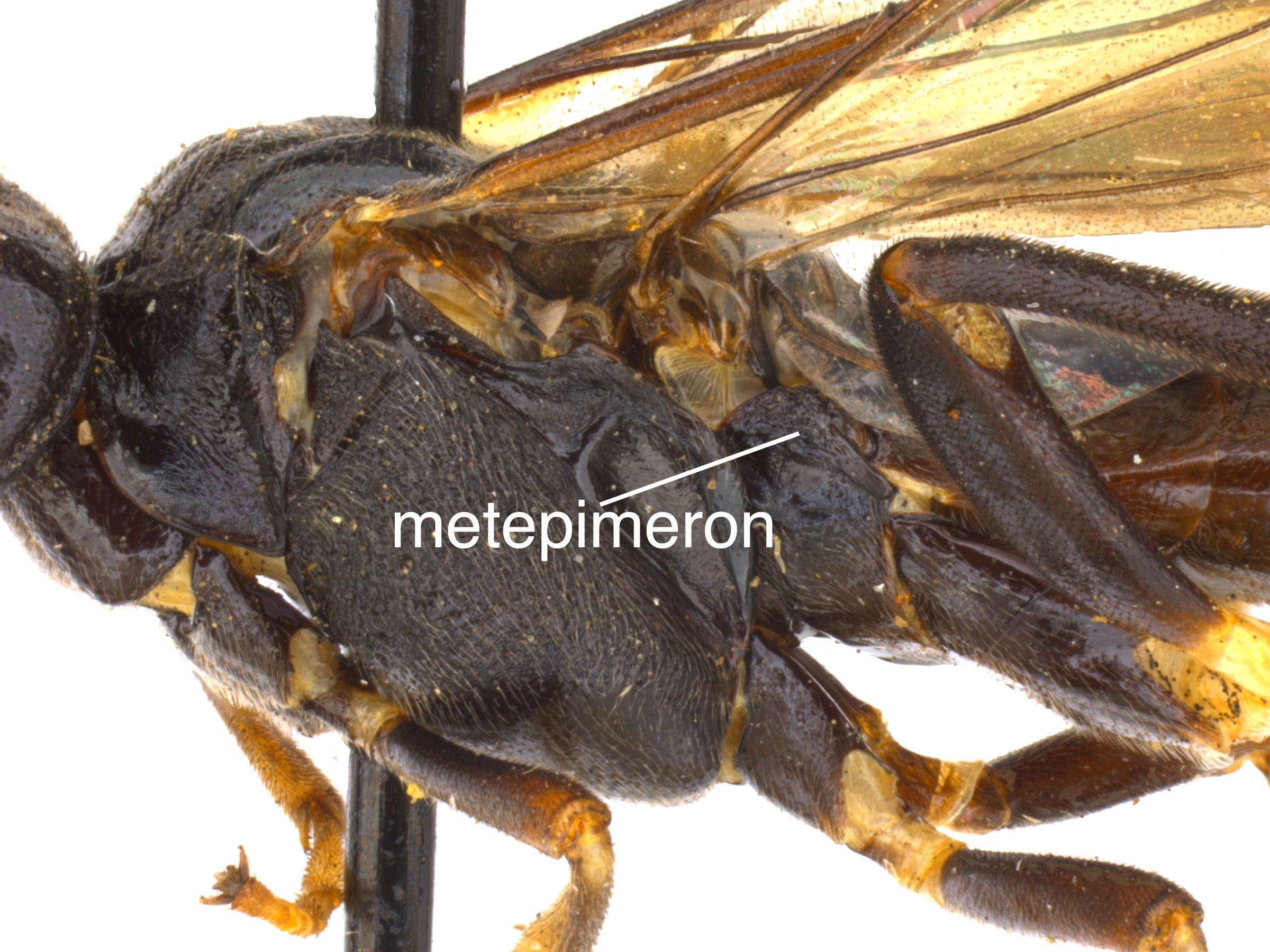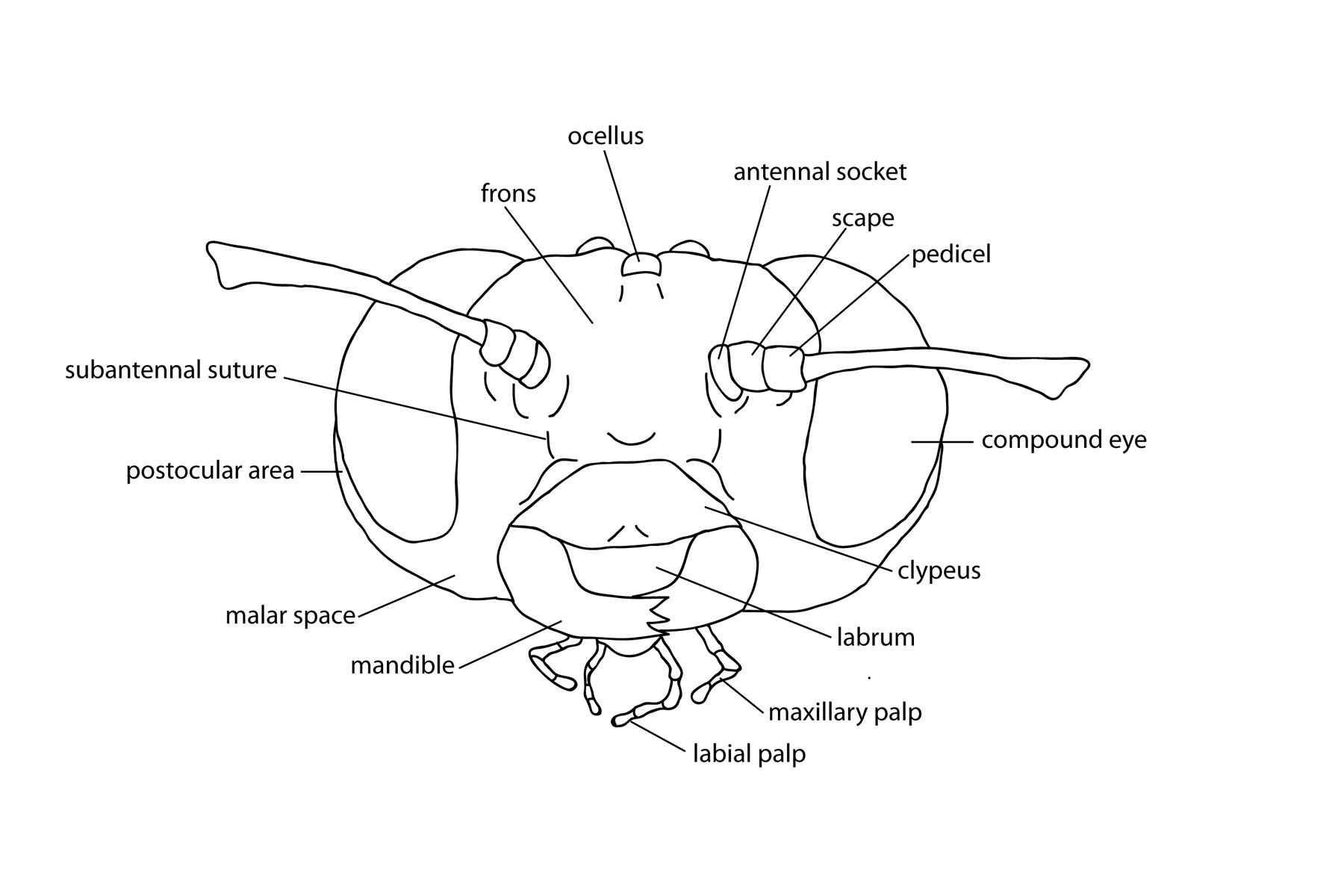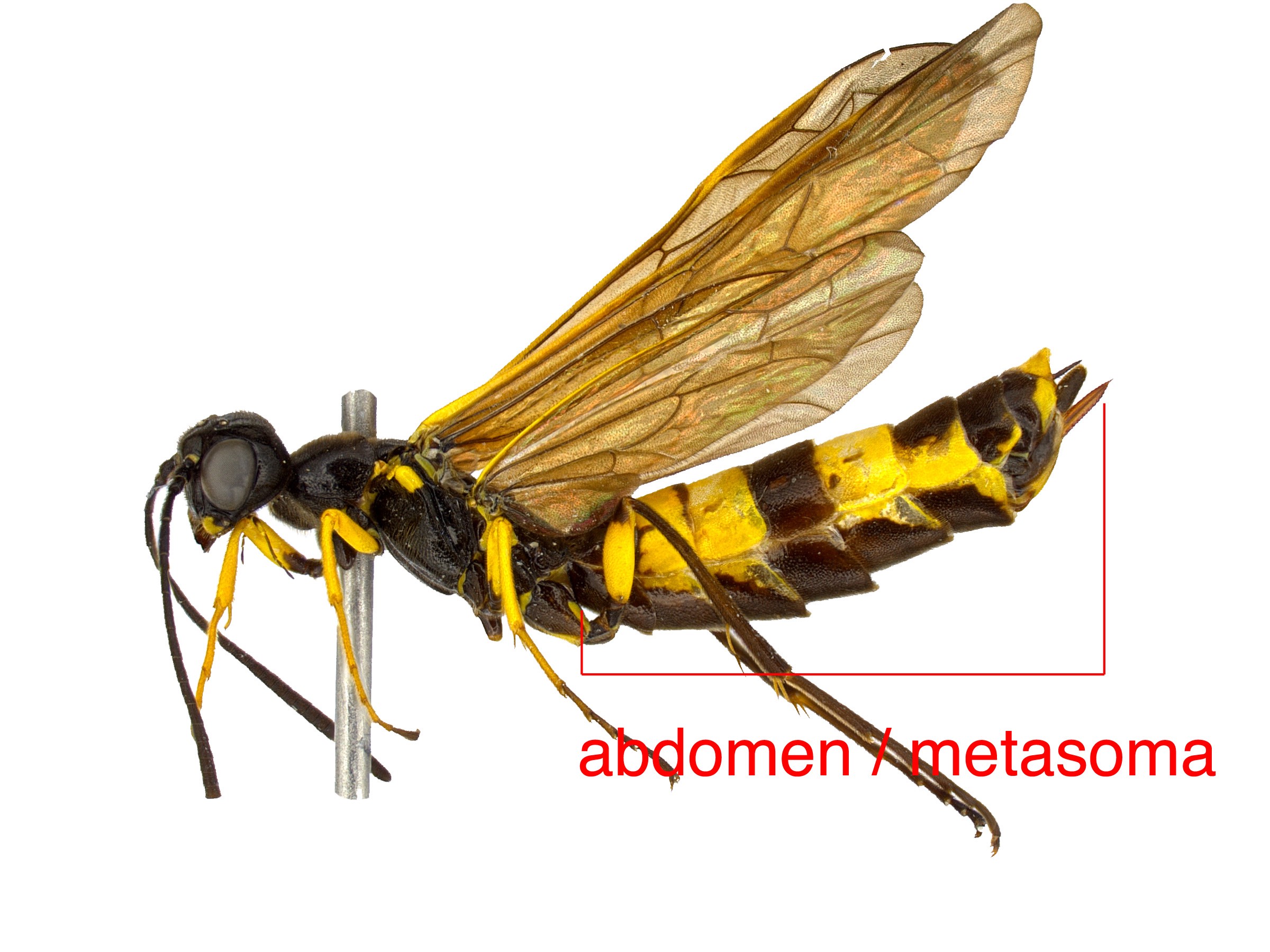Family: Argidae
Family common name: argid sawflies
Subfamily: Sterictiphorinae
Genus: Schizocerella Forsius, 1927
Subgenera: none
Argidae is a family of typical sawflies that are found in all non-polar regions of the world (Smith and Middlekauff 1987Smith and Middlekauff 1987:
Smith DR and Middlekauff WW. 1987. Suborder Symphyta. In: Stehr FW ed. Immature Insects. Kendall/Hunt Publishing Company. Vol. 1: 754 pp., Smith 1992Smith 1992:
Smith DR. 1992. A synopsis of the sawflies (Hymenoptera: Symphyta) of America south of the United States: Argidae. Memoirs of the American Entomological Society 39: 1-201.). They are external foliage feeders with a wide range of host plants. Additionally, this family exhibits some uncommon behaviors like the excretion of defensive compounds and subsocialsubsocial:
Living in aggregations but lacking organizational structure as in true social insects; can describes insects with tendencies to protect or care for thier young, feed gregariously, and build cocoon masses.
habits (Smith 1992Smith 1992:
Smith DR. 1992. A synopsis of the sawflies (Hymenoptera: Symphyta) of America south of the United States: Argidae. Memoirs of the American Entomological Society 39: 1-201.).
Schizocerella are small, about 4–6 mm in length, and in North America are generally orange and black in color. They are recognized by orange abdominal stripes and short, characteristic 3-segmented antennaeantenna:
the sensory organ emerging from the front of the head, usually between the compound eyes and above the clypeus; includes the flagellum, scape and pedicel
 , which in males are distinctly forked (Smith 1971cSmith 1971c:
, which in males are distinctly forked (Smith 1971cSmith 1971c:
Smith DR. 1971c. Nearctic sawflies of the genera Neoptilia Ashmead, Schizocerella Forsius, Aprosthema Konow, and Sphacophilus Provancher (Hymenoptera: Argidae). Transactions of the American Entomological Society 97: 537-594., Smith 1992Smith 1992:
Smith DR. 1992. A synopsis of the sawflies (Hymenoptera: Symphyta) of America south of the United States: Argidae. Memoirs of the American Entomological Society 39: 1-201., Vikberg 2004Vikberg 2004:
Vikberg V. 2004. Seasonal head dimorphism and taxonomy of some European species of Aprosthema (Hymenoptera: Symphyta: Argidae). Beitrauml;ge Zur Entomologie 54 (1): 107-125. https://doi.org/10.21248/contrib.entomol.54.1.107-125).
There are five species described worldwide, all but one restricted to the Americas. Two species occur in North America (Smith 1992Smith 1992:
Smith DR. 1992. A synopsis of the sawflies (Hymenoptera: Symphyta) of America south of the United States: Argidae. Memoirs of the American Entomological Society 39: 1-201., Hartsough et al. 2007Hartsough et al. 2007:
Hartsough CDB, Connor EF, Smith DR, and Spicer GS. 2007. Systematics of two feeding morphs of Schizocerella pilicornis (Hymenoptera: Argidae) and recognition of two species. Annals of the Entomological Society of America 100 (3): 375-380., Taeger et al. 2010Taeger et al. 2010:
Taeger A, Blank SM, and Liston AD. 2010. World Catalog of Symphyta (Hymenoptera). Zootaxa 2580: 1-1064.).
 (Smith 1992Smith 1992:
(Smith 1992Smith 1992: less than width of cenchruscenchrus:
less than width of cenchruscenchrus: (Smith 1992Smith 1992:
(Smith 1992Smith 1992: fused laterally with first tergitetergite:
fused laterally with first tergitetergite: (Smith 1992Smith 1992:
(Smith 1992Smith 1992: R open at apexapex:
R open at apexapex: short; length less than head width (Smith 1992Smith 1992:
short; length less than head width (Smith 1992Smith 1992: slightly laterally compressed (Smith 1992Smith 1992:
slightly laterally compressed (Smith 1992Smith 1992: (Smith 1992Smith 1992:
(Smith 1992Smith 1992: simple (Smith 1992Smith 1992:
simple (Smith 1992Smith 1992:The family Argidae can be distinguished from other sawfies by the single-segmented flagellumflagellum:
the third section of the antennae that includes all the segments beyond the pedicel; segments of the flagellum are known as flagellomeres
 of the antennaantenna:
of the antennaantenna:
the sensory organ emerging from the front of the head, usually between the compound eyes and above the clypeus; includes the flagellum, scape and pedicel
 . The genus Schizocerella can be distinguished from other genera in the family by the orange and black stripes on the abdomenabdomen:
. The genus Schizocerella can be distinguished from other genera in the family by the orange and black stripes on the abdomenabdomen:
the third and last segment of an insect's body; in sawflies this is usually made up of 11 segments (segments 9 and 10 often fused) , short antennaeantenna:
, short antennaeantenna:
the sensory organ emerging from the front of the head, usually between the compound eyes and above the clypeus; includes the flagellum, scape and pedicel
 , and its lack of a preapicalpreapical:
, and its lack of a preapicalpreapical:
close to, but anterior to, the apex
 spur. Males are distinguished from related genera Arge and Atomacera by the conspicuous forked antennaeantenna:
spur. Males are distinguished from related genera Arge and Atomacera by the conspicuous forked antennaeantenna:
the sensory organ emerging from the front of the head, usually between the compound eyes and above the clypeus; includes the flagellum, scape and pedicel
 (Smith 1992Smith 1992:
(Smith 1992Smith 1992:
Smith DR. 1992. A synopsis of the sawflies (Hymenoptera: Symphyta) of America south of the United States: Argidae. Memoirs of the American Entomological Society 39: 1-201.).
none
Larvae in North America feed on Portulaca oleraceae and other Portulaca sp. (purslane), and less commonly on Claytonia perfoliata (miner’s lettuce) (Smith 1992Smith 1992:
Smith DR. 1992. A synopsis of the sawflies (Hymenoptera: Symphyta) of America south of the United States: Argidae. Memoirs of the American Entomological Society 39: 1-201., Hartsough et al. 2007Hartsough et al. 2007:
Hartsough CDB, Connor EF, Smith DR, and Spicer GS. 2007. Systematics of two feeding morphs of Schizocerella pilicornis (Hymenoptera: Argidae) and recognition of two species. Annals of the Entomological Society of America 100 (3): 375-380.).
The female oviposits into an incision she makes on the edge of a leaf. Up to four eggs are deposited in each leaf. After hatching, larvaelarva:
the immature stage of holometabolous insects
 feed on the foliage of the plant. The two North American species of Schizocerella feed on the same host and have overlapping ranges, but have distinctly different feeding strategies. S. pilicornis is a leaf-miner and S. lineata is an external defoliatordefoliator:
feed on the foliage of the plant. The two North American species of Schizocerella feed on the same host and have overlapping ranges, but have distinctly different feeding strategies. S. pilicornis is a leaf-miner and S. lineata is an external defoliatordefoliator:
an insect that defoliates
. There are 5 larval instars. At maturity the prepupaprepupa:
the active, non-feeding life stage in which the larva prepares to enter the pupal stage
drops to the ground, burrows into the top 5 cm of soil, then builds a cocoon of woven fibers and bits of soil. After pupation, the adult chews a small hole in the cocoon, then climbs out of the soil. Adults typically live 25–27 hours, during which time they mate and reproduce (Gorske et al. 1977Gorske et al. 1977:
Gorske SF, Hopen HJ, and Randell R. 1977. Bionomics of the purslane sawfly, Schizocerella pilicornis . Annals of the Entomological Society of America 70 (1): 104-106.).
World: This genus ranges from as far north as Canada, as far south as Argentina. One species, S. pilicornis, has been introduced and is adventive in Australia (Smith 1971cSmith 1971c:
Smith DR. 1971c. Nearctic sawflies of the genera Neoptilia Ashmead, Schizocerella Forsius, Aprosthema Konow, and Sphacophilus Provancher (Hymenoptera: Argidae). Transactions of the American Entomological Society 97: 537-594., Smith 1992Smith 1992:
Smith DR. 1992. A synopsis of the sawflies (Hymenoptera: Symphyta) of America south of the United States: Argidae. Memoirs of the American Entomological Society 39: 1-201.).
North America: Schizocerella occurs from southern Canada south through Central America (Hartsough et al. 2007Hartsough et al. 2007:
Hartsough CDB, Connor EF, Smith DR, and Spicer GS. 2007. Systematics of two feeding morphs of Schizocerella pilicornis (Hymenoptera: Argidae) and recognition of two species. Annals of the Entomological Society of America 100 (3): 375-380.).
Map data from: GBIF.org (26 June 2019) GBIF Occurrence Download Schizocerella
Details about data used for maps can be found here.